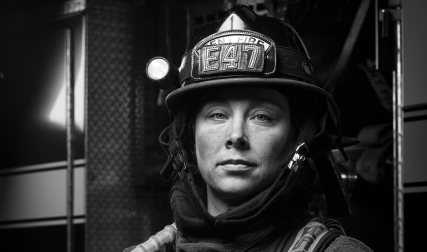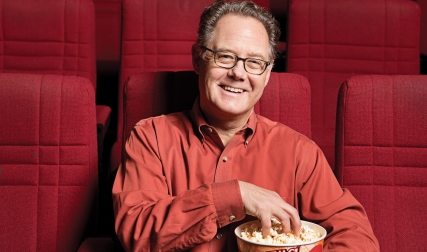He has been called “The Philosopher King of Impact Investing” and “The Most Fascinating Impact Investor You’ve Never Heard Of.” His publicist calls him “a bad-ass visionary.” Here he is on a panel at the European Commission’s Social Innovation Competition. There he is, presenting a radically innovative take on capitalism to global financiers in Costa Rica. Here he is speaking in the British Parliament. And there he is at the Vatican, meeting with the Catholic church’s financial advisors about how they might align the church’s enormous capital with its values.
Thinking and talking about how capital might better align with values is how Matthew Weatherley-White spends most of his time. “It’s not that capitalism doesn’t work,” he tells people. “It’s that capitalism in its current iteration doesn’t work. But capitalism evolves.”
Weatherley-White is the managing director of Caprock, a privately owned firm with 30 employees in five Western offices, with some 115 families and $3 billion under advisement. He’s been a professional investor for more than two decades. Capitalism, he likes to point out, is a powerfully efficient economic system, but it’s not monolithic: Its principles of self-interest, free markets and maximizing profit all adjust to changes in social and legal environments—changing, in the process, how profits are distributed and how businesses relate to society. “I’ve staked my reputation,” he says, “on the conviction that in the future it will be unacceptable (and unacceptably risky as an investment strategy) to deploy capital with disregard for the environmental and social consequences of doing so.”
Weatherley-White asserts that capitalism’s invisible hand eventually integrates new understanding through the millions of business, pricing and investment decisions made every day. “Capitalism is amoral,” he says, “but it evolves in step with society’s changing morals. In 50 years, people will look back on many of today’s practices the same way we look back now on colonialism, slavery and child labor. All were accepted practices in their time. Through time, some things simply become unacceptable.”
That promise of a capitalism fueled by impact investing is at the heart of Weatherley-White’s optimism. He describes impact investing as the cross-pollination between activists who want to see progressive change and capitalists who want to make money. And he believes that intersection—simply because of the sheer size of capital markets and their ability to reward and scale innovation—will succeed where philanthropists, nongovernmental organizations and governments have failed. “That evolved form of capitalism is not only our best hope for solving the seemingly intractable problems of our time,” he says, “it is our only rational hope.”
“Capitalism is amoral, but it evolves in step with society’s changing morals. In 50 years, people will look back on many of today’s practices the same way we look back now on colonialism, slavery and child labor. All were accepted practices in their time.”
Weatherley-White’s emergence in the financial world is an unlikely one. He took no college economics classes. He studied oceanography, classics, stage design and sociology, learned how to sculpt metal and wood, and ended up majoring in English. “I was full-tilt liberal arts,” he says. “I was broadly curious but had no clear path.”
He found his passion in the physically and mentally demanding sports of rowing and Nordic skiing. As a sophomore, he briefly held a world record on the indoor-rowing machine known as the “erg.” During a year away from Dartmouth, he won an Australian national championship with a Melbourne-based rowing club. Recruited out of Phillips Academy as an alpine skier, Weatherley-White instead walked on to Dartmouth’s Nordic team, where his stamina and self-taught proficiency in the emerging technique of skate-skiing made him one of the team’s fastest skiers. He had an unusually high tolerance for pain and, in his words, “a highly functioning obsessive-compulsive disorder, something that’s really useful if you want to succeed as an endurance athlete.”
Weatherley-White’s passion for endurance sports led him, after graduation, to Sun Valley, Idaho, a gorgeous spot to be a skiing and climbing bum. There, he pieced together what he calls “a classic dirt-bag life,” scraping money from odd jobs to fund his adventuring. He waited on tables, cleaned resort toilets, coached skiing, folded towels at a local athletic club, wrote for the local paper, sold some short stories, cooked meals for a wealthy family and scrounged free lodging. He also competed in endurance sports at an international level.
His parents, a prominent British surgeon father and American artist mother, had happily provided for his private education, but they refused to support him once he was on his own. “I asked my father for a $2,000 loan toward a down payment on a $52,000 house,” Weatherley-White recalls. “My dad said, ‘You know the rules. Find a house you can afford.’ Two thousand dollars was a rounding error for a surgeon. I was so angry that I didn’t talk to him for years. It was only later that I realized how important that lesson was.”
He decided he needed a plan beyond Sun Valley.
He applied to business school, but his heart wasn’t in it. He deferred admission to Tuck twice, once because the start of school conflicted with a climbing trip he’d planned in Canada, and ended up scrapping his plans for an M.B.A. Finally, in 1993, with a growing curiosity about the mechanics of the global economy, he managed to arrange an interview in Boise, Idaho, with Smith Barney, and a path opened before him.
For more than a decade, Weatherley-White was a mainstream stockbroker, jetting between Boise and New York City. After years of reading about how capital flowed through the system, he saw the machinery in motion from the inside.
Almost from the moment he started, when he was put in a room with other rookies to make hundreds of cold calls, he was disillusioned. He saw pressured, volume-based incentives, intentional obfuscation, insider information being used inappropriately, conflicts of interest—all of it regarded as business-as-usual in a culture where getting rich seemed to be the primary goal. His work became, he says, “a soul-crushing experience.” By the end, he was so embarrassed about the practices of his employers that he felt he needed to protect his clients from them.
In 2005 he walked away—down West Idaho Street, into a new office in Boise. With five like-minded partners and no clients, Weatherley-White set out to open “the kind of investment firm I would trust with my own money,” he says. To reduce the opaqueness and conflicts of interest he’d seen, he created an advisor-client model based on providing expertise and information, not on selling financial instruments and not on charging fees for transactions. The partners persuaded 40 high-net-worth families to allow them to manage and invest a collective pool of assets totaling $250 million, and Caprock was under way.
Two events in 2007 changed the way Weatherley-White went about his business. At a conference in Albuquerque, New Mexico, he met the founders of B Lab, a nonprofit that was promoting a new type of corporate structure called benefit corporations, or “B Corps.” Now legally recognized in 33 states, B Corps commit to meeting a set of standards of social and environmental performance along with accountability and transparency to both stakeholders and employees. Inspired, Weatherley-White guided his firm through the stringent B-Corp audit, earning Caprock the designation as one of 40 founding B-Corp companies—a group that has grown to include Patagonia, Ben & Jerry’s, Etsy, New Belgium Brewing and almost 2,400 other companies.
That same year, at an investor gathering called Zero Tradeoff in San Francisco, Weatherley-White was introduced to a question that took his principles of running a business and extended them to the way he invested his clients’ money: Is it possible to invest in socially and environmentally responsible companies and consistently earn a market rate of return? “For me,” says Weatherley-White, “that was a Jeffersonian question with profound implications. I began to explore it not out of any conviction but out of curiosity.”
Skeptics dismiss corporate social responsibility as public relations or idealistic nonsense, a distraction from a company’s more vital business. Followers of the modern portfolio theory believe that anything reducing the universe of potential investments—such as excluding companies because of social or environmental factors—leads to lower returns. Others, such as University of Michigan’s business school prof Aneel Karnani, believe that healthy markets inevitably support the public good. “If markets are working well then private profits and public interest are aligned together.…Shareholder pressure and competent managers will more effectively lead to firms maximizing profits, which will simultaneously increase social welfare,” he wrote in his 2010 study, “Doing Well by Doing Good: The Grand Illusion.”
Weatherley-White believes that a long-accepted convention is simply no longer true: Investors don’t have to choose between making a profit and making a difference.
But without agreed-upon metrics or methodologies, Weatherley-White found definitive information hard to come by. He learned that the KLD 400 Social Index—which tracks 400 socially responsible companies across a range of industries—was consistently performing in line with the S&P 500. The “Clean 200” had beaten the Carbon Intensive Index every year since 2004. He found instances of organic farms outperforming conventional farms, green buildings returning higher rates than conventional ones, of sustainable forestry practices producing more durable returns across longer periods of time than conventional forestry. He was looking for proof—acknowledging, he admits, his own confirmation bias—and he found it.
At Caprock, Weatherley-White put his money where his growing confidence was and created a separate platform dedicated to investing in so-called impact funds that finance companies and projects delivering social or environmental benefits. Those impact funds, now encompassing more than $1 billion of Caprock’s total portfolio, have generated enough solid, market-competitive returns that Weatherley-White believes the long-accepted convention is simply no longer true: Investors don’t have to choose between making a profit and making a difference.
His conversation at the Vatican had centered on just that point. Commenting on his blog afterward, Weatherley-White said he’d gotten the sense that the church was totally behind the concept of impact investing—it just couldn’t lead it. He said, “I think the financial advisors were looking for somebody to provide air cover for what could be a transformative shift in the way the church manages its money.”
An example of one of the funds in Caprock’s impact portfolio is Fresh Coast Capital, which is financing the planting of hybrid poplar trees on swaths of brownfields and abandoned manufacturing properties across America’s Rust Belt. Building green infrastructure costs less than hard landscaping with pavement and cement. According to Fresh Coast’s prospectus, its urban forestry projects remediate contaminated sites while reducing crime rates and increasing property values. The fast-growing trees begin generating income for biomass, paper and lumber products in just four years. Along the way, they also sequester carbon from the atmosphere and, crucially, absorb a significant amount of storm water. Cities are required to pay Fresh Coast a portion of the savings in storm water management costs. Those payments increase its return on investment to attractive returns.
Caprock has invested in net-zero energy housing developments in Seattle, renewable energy projects in South America, agricultural projects in Africa, and other initiatives where, Weatherley-White says, investments are helping solve problems of resource depletion, income inequity and access to public services. In many cases, the return on investment is bolstered by a suite of credits, tax breaks and incentives that reward the social benefits of the projects. Weatherley-White points to a recent large timberland sale in which the wetlands mitigation payments and carbon credits were worth more than the actual standing timber. Some argue that such government-enhanced returns on investment aren’t pure capitalism. Weatherley-White sees them through a less conventional lens: as examples of “capital stacking.” He contends that using different types of capital at different points in a deal structure can optimize the efficacy of each—to the benefit of investors.
“This isn’t about purity,” says Weatherley-White. “It’s about direction. My orientation is toward better. Now, the evidence on market return is still somewhat anecdotal,” he says. “But the outlines are clearly emerging. We’ve moved from the hope stage into the proof stage. The next stage is scale.”
The scale part is what excites him. The recent creation of Bain Capital’s $390-million Double Impact Fund (led by former Massachusetts Gov. Deval Patrick) and TPG’s $2-billion Rise Fund signal that impact investing has already begun shifting into a new scale of capital markets. The Ford Foundation has announced its intention to convert $1 billion of its $12-billion endowment to impact investing during the next 10 years.
During the past two years, Weatherley-White has turned most of his attention to raising awareness of impact investing to accelerate the shift. He grudgingly hired a publicist. He created a Twitter account. He paid his own way to speak at any conference that would have him and talked to any reporter who would listen to him. He racked up more than 100,000 miles the first year, flying coach. “This isn’t about market-share capture or promoting Caprock,” he says. “This is about moving the markets.”
Within a remarkably short time, he’s developed a national and international platform, and, suddenly, finds himself in demand.
Part of his appeal may come from his stance straddling two worlds. He considers himself a forward-looking, pragmatic environmentalist. He is a former practicing Buddhist (“I think that’s made me more mindful, more willing to sit in contemplation in a fast-paced industry”) and sometime poet. He’s confident he can talk to both Woodstock and Wall Street.

Part of his appeal may be the unconventional figure he cuts in the buttoned-down world of high finance. At 54, Weatherley-White is perpetually tanned, perpetually jazzed, with a dazzling smile, a swept-back mane of graying hair and the physique of an elite athlete half his age. He shows up at formal events in jeans and an open-collared shirt. He has the wings of the Greek god Hermes tattooed on his ankles. He begins each day with four hours of “white space”—a block of unstructured, unscheduled time that allows him to proactively think and write, respond to email, draft blog posts and conference talks and op-ed pieces. He lives with his girlfriend (he is divorced, with a 7-year-old daughter) in a modest, sparsely decorated, mid-century ranch house in Boise and bikes to his office. He schedules his work and travel around running and surfing and skiing and competitive cycling. He holds nonresident memberships at rowing clubs in six cities.
Financial gurus such as Jed Emerson, a strategic impact advisor and senior research fellow at the Center for Social Investment, and Joel Solomon, author of The Clean Money Revolution, see Weatherley-White as an up-and-comer with the background to back up what he preaches. Both of them say you can tell he’s on to something because he gets critiqued by the mainstream financial lords on one side and by small-scale activists on the other, neither side buying the premise that investors can have it both ways.
As venture capitalist Marc Andreessen, cofounder of Netscape, famously put it, “[Impact investing] is like a houseboat; it’s not a great house and not a great boat.” Barry Ritholtz, author, Bloomberg columnist and chairman of Ritholtz Wealth Management, says, “I hope Matthew’s right. I fear there’s a little wishful thinking on his part.”
“I don’t know that I’m right,” says Weatherley-White. “I suspect that I am right. But more to the point, the question needs to be asked: Can capitalism do better? Can capitalism internalize these heretofore externalized environmental and social costs? If it can—and if we as a society decide that it should—then it will. It just will. If it can’t, then, well, we have a very different and difficult set of challenges. What I want is for people to just start asking that question.”
HOW YOU CAN MAKE AN IMPACT
Five tips from Matthew Weatherley-White
Ignore ESG at your peril. “ESG means environmental, social and governance factors. The largest asset manager in the world, BlackRock, has integrated it into its investment decision-making process. ESG is why the largest sovereign wealth fund in the world, Norway’s Sovereign Wealth Fund, identifies as a material risk ‘stranded carbon’ (assets whose values may plummet as a result of green regulations). And ESG is why the World Bank has stopped financing new oil and coal projects. If they are all intensely focused on ESG, it would be wise for individual investors to pay attention.”
Seek mispriced risk. “It’s your friend. The wise investor spends an entire career looking for mispriced risk. When money runs from a deal, sometimes the best thing to do is run toward it. So, for example, when financing for a renewable energy project isn’t trending, opportunity may be knocking. And when an entire field flashes yellow for no reason beyond unfamiliarity bias, sometimes it pays to be a contrarian.”
Understand what “sustainability” really means. “This term has been tainted. It isn’t merely about greening the economy. It means improving operating efficiency and minimizing extractive footprints. Find the companies that understand that, and you may find some real gems.”
Distinguish between values and value investing. “Some investors often confuse values investing (aligning their capital with their personal values) with value investing (seeking to invest in a solid company at a reasonable valuation). This can cause paralysis and thus be a profound mistake because the two can be contradictory. On the other hand, some fantastic value-oriented opportunities also happen to be wonderful values-oriented opportunities.”
Be nimble. “ ‘The perfect is the enemy of the good,’ said Voltaire. So don’t be intimidated or paralyzed by the ideal of perfection. The markets are the most powerful optimization mechanism ever created. Instead, let’s seek to orient capitalism toward better rather than the status quo. Do that, and imagine what the future might hold!”
Jim Collins is a former editor of DAM.




